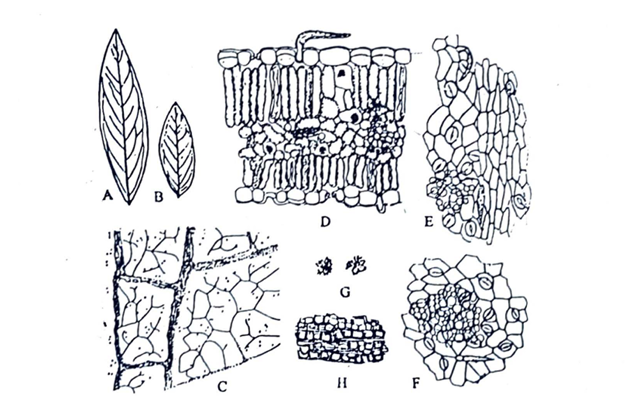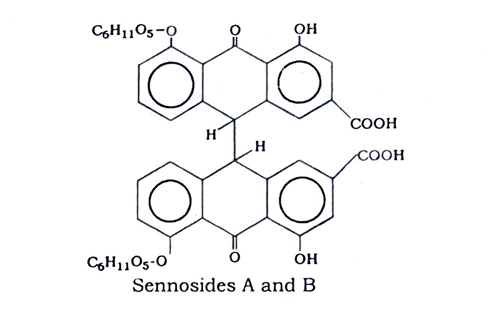Synonyms: Senna Leaves, Folia Sennae
Senna Leaves Botanical source: Senna consists of the dried leaflets of Cassia senna Linn. (Cassia acutifolia Delile) (known in commerce as Alexandrian or Egyptian Senna) and Cassia Angustifolia Vahl. (commercially known as Tinnevclly Senna). The plants, which are small shrubs, belong to the family Caesalpinaceae.
Geographical source: Cassia senna is indigenous to tropical Africa and is cultivated in Sudan. Cassia angustifolia is indigenous to Somaliland, Arabia, Sind and the Punjab, and 1s cultivated in South India (Tinnevelly district).
Mictoscopical characters of senna leave
Leaflets are sessile, 2.-0 to 3.5 cm (Alexandrian) or 2.5 to 5 cm (Tinnevelly) long, lanceolate to ovate-lanceolate in shape and pale grayish green in colour. Surface pubescent, margin entire, apex acute, base asymmetrical, odour faint, taste mucilaginous and somewhat bitter.

Fig. 30: Senna. A, leaflet of Cassia angustifolia; B. leaflet of C. senna; C, diagram of a piece of lamina showing veins and veinlets and distribution of calcium oxalate prisms and clusters; D. t.s. of lamina; E & F, lower and upper epidermises; G. cluster crystals; H, large veinlet with prisms.of calcium oxalate, c, cell contents; 1, elongated cells, m, mucilage; p.f., pericyclic fibres; s, stoma; t, trichomc, xy, xylem. (Reconstructed from Wallis).
Microscopical Characters of Senna Leave
Epidermal cells are polygonal, straight walled and contain mucilage. Paracytic (rubiaceous) stomata re present on both upper and power eipdermises. Trichomcs conical unicellular, thick walled, warty and frequently curved near the base. Numerous clusters of calcium oxalate occur in the mesophy)] and prisms occur in the form of sheath along the veins. Single layer of palisade cells beneath each epidermis. Xylem clements are with spiral and annular thickenings.
Chemical Constituents of Senna Leave
Principal constituents of Senna are anthraquinone glycosides, which include senno_sides A, B, C and D rhein and aloe-emodin. Senna also contains kaempferol (a ) ) yellow flavonol).

Sennosides A and 8
Uses: Senna is very popularly used as a purgative drug in the treatment of both casual and habitual constipation.
Substitutes and adulterants
Substitutes and adulterants of Senna· include the leaves and leaflets of the following related plants: Cassia obovata (Dog Senna), wild plants of C. angustifolia (Arabian Senna). Cassia auriculata (Pal the’ Senna). Colutea arborescens, Tephrosia apollinea and Ailanthus glandulosa.


Very nice and useful information.
A very useful and informative websites for the study of pharmacognosy studies especially for drugs info …. The language is so liberal so that non pharma (bio also)students could understand.